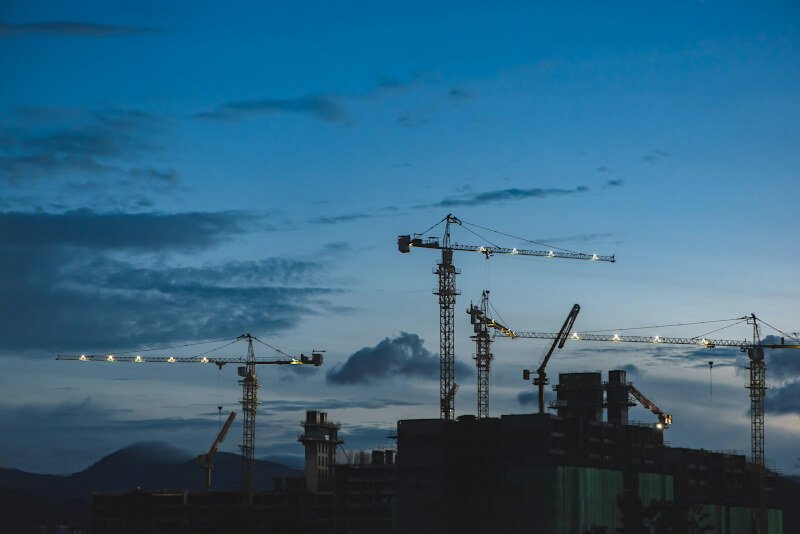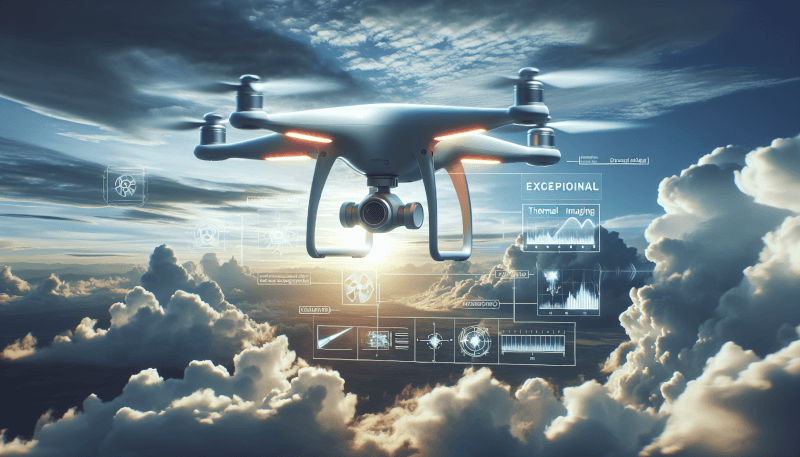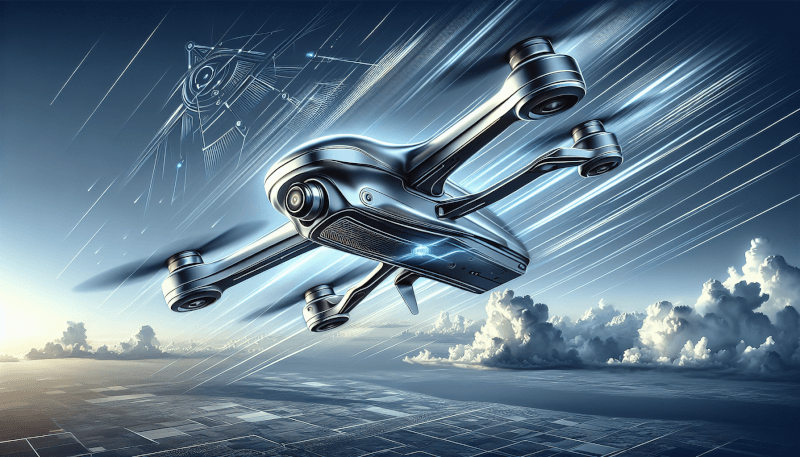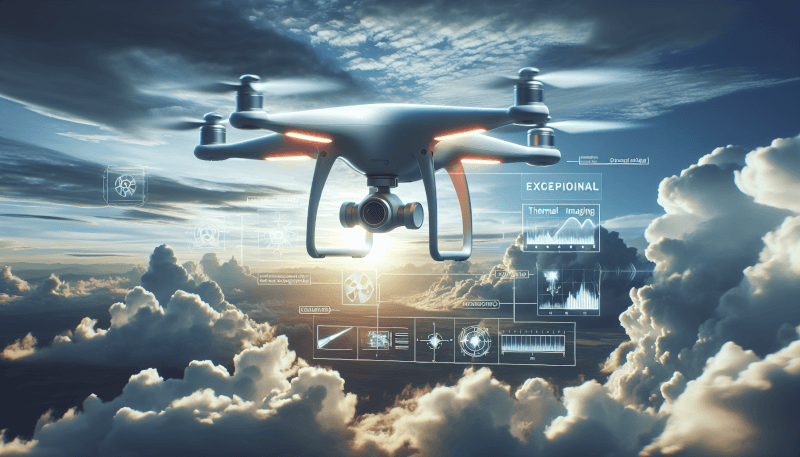If you’re looking to take your aerial photography and videography skills to the next level, then look no further than professional-grade thermal imaging drones. These drones are equipped with advanced thermal imaging technology that allows you to capture stunning visuals even in low-light or challenging conditions. In this article, we will provide you with a comprehensive buyer’s guide to help you navigate through the various options available in the market, ensuring you make an informed decision when investing in a thermal imaging drone. From understanding the key features to consider, to exploring different models and their capabilities, we’ve got you covered. So, let’s embark on this exciting journey and discover the world of professional-grade thermal imaging drones together!
Understanding Thermal Imaging Drones
Thermal imaging drones are unmanned aerial vehicles equipped with thermal cameras that allow you to capture images and videos of the thermal radiation emitted by objects. These drones use infrared technology to detect and measure heat, enabling you to visualize temperature differences and identify hotspots. This technology has a wide range of applications, from search and rescue missions to building inspections and wildlife monitoring.
Principles of Thermal Imaging
Thermal imaging is based on the principle that everything with a temperature above absolute zero emits infrared radiation. Thermal cameras can detect this radiation and convert it into a visual representation of temperature. The images produced by thermal cameras are commonly referred to as thermograms or infrared images. Each pixel in a thermogram represents the temperature of the corresponding point in the scene, allowing you to identify temperature variations and anomalies.
Advantages of Thermal Imaging Drones
Thermal imaging drones offer several advantages over traditional methods of temperature measurement and inspection. Firstly, they provide a safe and efficient way to survey large areas and inaccessible locations, such as rooftops or tall structures. Drones can easily navigate challenging environments, reducing the need for manual labor or expensive equipment. Additionally, thermal imaging drones can capture real-time data and provide instant feedback, allowing for quick decision-making and problem-solving. With the ability to cover large areas in a short amount of time, these drones are a valuable tool for professionals in various industries.
Choosing the Right Thermal Imaging Drone
When choosing a thermal imaging drone, there are several key considerations to keep in mind. The following factors will help you select a drone that meets your specific needs and requirements.
Budget Considerations
Before diving into the world of thermal imaging drones, you should determine your budget. Understanding your financial constraints will narrow down your options and prevent overspending. It is important to strike a balance between cost and quality, ensuring that you get the best value for your investment.
Payload Capacity
The payload capacity of a thermal imaging drone refers to its ability to carry additional equipment, such as thermal cameras and other accessories. The payload capacity determines the maximum weight that the drone can lift and carry during flight. It is crucial to consider the weight of the thermal camera and any other tools you may need to attach to the drone when assessing its payload capacity.
Flight Time and Range
Flight time and range are important factors to consider when choosing a thermal imaging drone. Flight time refers to the duration for which the drone can remain airborne on a single battery charge. Longer flight times allow for extended missions and increased productivity. Range, on the other hand, refers to the distance that the drone can travel away from the remote controller. Depending on your specific requirements, you may need a drone with a longer flight time and range.
Camera Specifications
The camera specifications play a crucial role in the quality and accuracy of the thermal images and videos captured by the drone. Key camera specifications to consider include resolution and sensitivity, spectral range, field of view (FOV), refresh rate, and image and video storage capabilities. Higher resolution and sensitivity allow for more detailed and precise thermal images, while a wider spectral range ensures the capture of a broader range of temperatures. The field of view determines the area that the camera can capture in a single frame, while the refresh rate affects the smoothness of video recordings.
Integration with Software
When choosing a thermal imaging drone, it is important to consider its compatibility with thermal analysis software. This software allows you to analyze and interpret the thermal data collected by the drone, providing valuable insights and facilitating informed decision-making. Additionally, consider the ease of data transmission and storage, real-time data visualization capabilities, and the drone’s data processing and analysis capabilities.
Ease of Use
The ease of use of a thermal imaging drone is crucial, especially if you are new to operating drones. Consider your familiarity with drone operations and assess the controller interface and functions. Look for drones with user-friendly settings and options that simplify the flying and imaging process. Automated flight modes and mobile app compatibility can also enhance the user experience and make the drone easier to control.
Durability and Build Quality
When investing in a thermal imaging drone, it is important to assess its durability and build quality. Drones may encounter challenging environmental conditions, such as wind, rain, and extreme temperatures. Therefore, it is important to choose a drone that is built to withstand these conditions. Consider the materials and construction of the drone, as well as its weather and impact resistance. Ease of maintenance and field repairability are also important factors to consider, as they can affect the longevity and reliability of the drone.
Service and Warranty
Thermal imaging drones are sophisticated pieces of equipment that may require occasional maintenance or repairs. It is important to choose a drone from a reputable manufacturer that offers reliable service and support. Consider the supplier’s reputation and track record, as well as the availability of technical support and training options. Additionally, assess the warranty provided with the drone to ensure you are protected against any potential manufacturing defects or malfunctions.
Regulatory Compliance
Operating a drone, including a thermal imaging drone, often requires compliance with specific regulations and guidelines established by aviation authorities. It is important to ensure that the drone you choose complies with the regulations applicable to your region. Familiarize yourself with the legal requirements and restrictions for drone operations, such as obtaining the necessary permits or licenses. Failure to comply with these regulations can result in legal consequences and compromise the safety and legality of your operations.
Supplier Support and Training
Lastly, when choosing a thermal imaging drone, consider the level of support and training provided by the supplier. Look for suppliers that offer comprehensive training programs to ensure you are proficient in operating the drone and utilizing its features effectively. Additionally, consider the availability of upgrades and future-proofing options to ensure that your drone remains up-to-date with the latest technological advancements.

Budget Considerations
Determining your budget is the first step in the process of choosing a professional-grade thermal imaging drone. By establishing a budget, you can focus your search on drones that fall within your financial constraints. Consider the overall cost of the drone, including any necessary accessories or additional equipment. It is also important to factor in the long-term costs, such as battery replacements or software subscriptions.
Comparing Pricing
Once you have determined your budget, compare the pricing of different thermal imaging drones. Take into account the features, specifications, and capabilities offered by each drone at various price points. It is important to strike a balance between cost and quality. While you may be tempted to opt for the cheapest option, it is essential to consider the reliability and performance of the drone to ensure you are getting value for your money.
Understanding Value for Money
When evaluating the value for money offered by a thermal imaging drone, consider its overall capabilities and its suitability for your specific needs. A more expensive drone may provide advanced features and higher-quality thermal images, which can be advantageous for certain applications. On the other hand, a more affordable drone may meet your basic requirements without compromising on essential functionality. It is important to assess the trade-offs between price and performance to ensure that you are making a well-informed decision.
Payload Capacity
The payload capacity of a thermal imaging drone refers to its ability to carry additional equipment, such as thermal cameras and accessories. Understanding the payload capacity is crucial, as it determines the maximum weight that the drone can lift and carry during flight.
Types of Thermal Cameras
When considering the payload capacity, it is important to understand the different types of thermal cameras and their weights. There are various types of thermal cameras available, ranging from lightweight handheld devices to more robust and heavy-duty models. Consider the weight of the thermal camera you intend to attach to the drone when assessing its payload capacity.
Choosing the Right Payload Capacity
To choose the right payload capacity for your thermal imaging drone, you need to consider the weight of the thermal camera and any other tools or accessories you may need to attach. Ensure that the drone’s payload capacity exceeds the total weight of the equipment to ensure safe and stable flight. It is always recommended to leave some margin between the payload capacity and the actual weight to account for variations and unexpected circumstances.
Understanding the Importance of Payload Weight
The weight of the payload can have a significant impact on the flight performance and stability of the drone. Exceeding the recommended payload weight can lead to reduced flight time, decreased maneuverability, and increased power consumption. It is important to find the right balance between the payload weight and the drone’s capabilities to ensure optimal performance and safe operations.

Flight Time and Range
Flight time and range are important considerations when choosing a thermal imaging drone. The flight time refers to the duration for which the drone can remain airborne on a single battery charge, while the range refers to the distance that the drone can travel away from the remote controller.
Understanding Flight Time
Flight time is a crucial factor, as it determines the duration for which you can effectively use the drone during a single operation. Longer flight times allow for extended missions and increased productivity. Consider the specific tasks you intend to perform with the drone and ensure that the flight time meets your requirements. It is also important to take into account any additional weight added to the drone, such as thermal cameras or extra batteries, as they can reduce the overall flight time.
Factors Affecting Flight Time and Range
Several factors can affect the flight time and range of a thermal imaging drone. These include the battery capacity, the weight of the drone and its payload, weather conditions, and flying speed. It is important to consider these factors when assessing the expected flight time and range of a drone. Additionally, keep in mind that the flight time and range provided by manufacturers are often based on ideal conditions and may vary in real-world scenarios.
Choosing the Optimal Flight Time and Range for Your Needs
To choose the optimal flight time and range for your needs, consider the specific tasks and applications you will be using the drone for. If you require longer flight times and extended ranges, you may need to invest in additional batteries or choose a drone with a higher-endurance capability. However, if your operations are relatively short and confined to a specific area, a drone with a shorter flight time and range may be sufficient.
Camera Specifications
The camera specifications of a thermal imaging drone play a crucial role in the quality and accuracy of the thermal images and videos captured. It is important to understand and evaluate the different camera specifications when choosing a drone.
Resolution and Sensitivity
The resolution of a thermal camera refers to the number of pixels it can capture in a single image. Higher resolution allows for more detailed and precise thermal images. Sensitivity, on the other hand, refers to the camera’s ability to detect small differences in temperature. A more sensitive camera can capture subtle temperature variations, providing more accurate and reliable results.
Spectral Range
The spectral range of a thermal camera refers to the range of wavelengths that it can detect. Different materials emit and absorb radiation at different wavelengths. By choosing a camera with a wider spectral range, you can capture a broader range of temperatures and detect thermal anomalies more effectively.
FOV (Field of View)
The field of view (FOV) of a thermal camera determines the area that it can capture within a single frame. A wider FOV allows for the capture of larger areas, which can be beneficial when conducting surveys or inspections. However, a wider FOV may result in reduced image resolution, as the same number of pixels are spread over a larger area.
Refresh Rate
The refresh rate of a thermal camera refers to the frequency at which it can capture and display thermal images. A higher refresh rate provides smoother video recordings and allows for better visualization of rapidly changing temperature patterns. Consider the specific requirements of your applications when assessing the optimal refresh rate for your thermal imaging drone.
Image and Video Storage
When considering the camera specifications, it is important to assess the image and video storage capabilities of the drone. Determine the amount of storage space available and evaluate whether it is sufficient for your needs. Consider the ability to transfer the captured thermal data to an external device for further analysis and archiving.
Additional Features and Accessories
Thermal imaging drones may offer additional features and accessories that enhance their functionality and versatility. These may include built-in GPS systems for precise navigation, obstacle avoidance systems for increased safety, or specialized software for advanced data analysis. Consider your specific requirements and assess the availability and compatibility of these additional features and accessories.

Integration with Software
Integration with thermal analysis software is an important consideration when choosing a thermal imaging drone. The software allows you to analyze and interpret the thermal data captured by the drone, providing valuable insights and facilitating informed decision-making.
Compatibility with Thermal Analysis Software
Ensure that the thermal imaging drone you choose is compatible with the thermal analysis software you intend to use. The software should be able to process and interpret the thermal data captured by the drone, allowing for detailed analysis and reporting. Verify the compatibility and functionality of the software with the drone’s data format and output.
Data Transmission and Storage
Consider the ease of data transmission and storage when choosing a drone. Look for drones that offer seamless data transfer to a computer or other external devices for analysis and storage. Some drones may offer wireless data transmission options, allowing for real-time monitoring and immediate analysis of the thermal data.
Real-time Data Visualization
Real-time data visualization capabilities can greatly enhance the usability and effectiveness of a thermal imaging drone. Look for drones that provide live thermal imaging feeds to a compatible mobile device or ground station. This allows you to monitor and analyze the thermal data in real-time, enabling immediate decision-making and problem-solving.
Data Processing and Analysis Capabilities
Evaluate the data processing and analysis capabilities of the drone and any accompanying software. Look for features that allow for advanced data manipulation, such as temperature measurements, anomaly detection, or image fusion. The ability to generate reports and export data in various formats can also be beneficial for documentation and collaboration purposes.
Ease of Use
The ease of use of a thermal imaging drone can greatly impact your overall experience and productivity. Consider your familiarity with drone operations and assess the various features and functionalities that contribute to ease of use.
Familiarity with Drone Operations
If you are new to operating drones, it is important to choose a thermal imaging drone that is beginner-friendly. Look for drones that offer intuitive controls and user-friendly interfaces. Some drones may offer guided tutorials or flight assistance features to help you get started. It is also beneficial to choose a drone that can be easily integrated into your existing workflow.
Controller Interface and Functions
Assess the controller interface and functions of the drone to ensure they are user-friendly and intuitive. Consider the layout of the controls, the functionality of the buttons and switches, and the ease of navigation through various menus and settings. A clear and well-designed controller interface can greatly enhance your flying and imaging experience.
Automated Flight Modes
Drones with automated flight modes can simplify the flying process and improve the quality of the captured thermal data. Look for drones that offer features such as waypoint navigation, follow-me modes, or automated inspection paths. These features allow for precise and repeatable flights, reducing the need for manual control and increasing efficiency.
Mobile App Compatibility
Consider the compatibility of the drone with mobile apps. Many thermal imaging drones offer companion apps that allow you to control and monitor the drone using a mobile device. These apps may provide additional features, such as FPV (First Person View) streaming, autonomous flight control, or post-flight data analysis. Assess the availability and functionality of the mobile app when choosing a thermal imaging drone.
User-Friendly Settings and Options
Thermal imaging drones should offer user-friendly settings and options that allow for easy customization and optimization. Look for drones that provide clear and concise menus, as well as helpful prompts and explanations. Customizable settings, such as temperature scales or color palettes, can also enhance your ability to interpret and analyze the thermal data effectively.

Durability and Build Quality
Durability and build quality are crucial considerations when choosing a thermal imaging drone. Drones may encounter challenging environmental conditions and potential hazards during operations. Therefore, it is important to select a drone that is built to withstand these conditions and can withstand occasional impacts or accidents.
Materials and Construction
Assess the materials and construction of the drone to determine its durability and longevity. Look for drones made from high-quality materials that can withstand wear and tear. Carbon fiber or sturdy plastic materials are commonly used in the construction of drones, providing a good balance between durability and weight.
Weather Resistance
Ensure that the drone you choose is weather-resistant and can withstand exposure to various environmental conditions. Look for drones that are rated for water and dust resistance, as this can greatly extend their lifespan and reliability. Consider the international protection (IP) rating of the drone, which indicates its level of resistance to dust and water.
Impact Resistance
Consider the impact resistance of the drone, as occasional accidents or collisions may occur during operations. Look for drones that have protective measures in place, such as propeller guards or reinforced frames. These features can minimize the risk of damage and prolong the life of the drone.
Ease of Maintenance
Evaluate the ease of maintenance of the drone, as regular maintenance is important for optimal performance and longevity. Look for drones that allow for easy access to internal components, such as batteries or motors. User-friendly maintenance procedures can save time and effort, ensuring that the drone remains in good working condition.
Field Repairability
In the event of a minor accident or malfunction, it is beneficial to have a drone that can be easily repaired in the field. Look for drones that provide modular designs and readily available spare parts. This allows for quick and cost-effective repairs, minimizing downtime and increasing operational efficiency.
Supplier Support and Training
When investing in a professional-grade thermal imaging drone, consider the level of support and training provided by the supplier. A reputable supplier can offer valuable support, technical assistance, and training options to ensure that you can maximize the capabilities of your drone.
Supplier Reputation and Track Record
Research the reputation and track record of the supplier before making a purchase. Look for suppliers with a proven history of providing reliable products and excellent customer service. Consider reviews and testimonials from other customers to get an idea of the supplier’s reliability and commitment to customer satisfaction.
Technical Support and Training Options
Assess the availability and quality of technical support provided by the supplier. Look for suppliers that offer timely and responsive technical assistance, whether through phone, email, or online support channels. Consider the availability of training options, such as user manuals, online tutorials, or in-person training sessions. These resources can help you become proficient in operating the drone and utilizing its features effectively.
Upgrades and Future Proofing
Consider the supplier’s commitment to product upgrades and future-proofing. Technology is constantly evolving, and it is important to choose a supplier that offers regular firmware updates and software enhancements. This ensures that your drone remains up-to-date with the latest technological advancements and can adapt to changing industry requirements. Additionally, assess the availability of accessories and compatible upgrades that can expand the capabilities of your drone in the future.
In conclusion, understanding the principles of thermal imaging and the various considerations when choosing a thermal imaging drone is essential to make an informed decision. The budget, payload capacity, flight time and range, camera specifications, integration with software, ease of use, durability and build quality, service and warranty, regulatory compliance, and supplier support and training are all important factors to evaluate. By carefully assessing these factors, you can choose the right thermal imaging drone that meets your specific needs and requirements.



